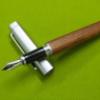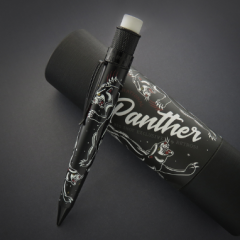Search the Community
Showing results for tags 'lucky'.
-
As mentioned in another thread -- -- the parcel my brother'd sent me from the States arrived after a little more than a month in transit yesterday. At around 11:20. I put away the notebooks and checked out the two gel pens and gel-pen refills and finally came to the Kaweco M nib. I pulled out my Kaweco Special, took out its EF nib, and installed the M nib. Inked up the pen. Noodler's Black, duh. Wow. What a wet nib! Much more like a B line, or maybe M lines have always been so fat. Set the pen aside, cos I had changed the ink in a Pilot 823 (PO), from Pilot Blue-Black to KWZi Niebieski galusowy #3, tra la la... la la la... picked up the Kaweco Special, and... fumble-fingers dropped it straight down onto the floor. It was 14:42. I couldn't help but laugh. Here, it'd taken this nib over a month to reach me (and I could have ordered one more cheaply from one of my favorite "local" (in Kraków) pen shops) and not even two-and-a-half hours later, I'd turned it into...hey, that looks like a PO nib! Hahahahaha. I wasn't crazy about the M nib and had been thinking of modifying it (by a professional), and I feel sooooo lucky that it was the Kaweco that I'd fumbled and not the Pilot 823. Or the Nakaya Piccolo (also on the table at the time). I took the nib out of the Special and bent it back about halfway before sticking it into an AL Sport, for further testing. It still looks like a PO nib and writes with a tiny bit of scratching, nothing a little more tweaking couldn't fix. Probably. So... what have y'all dropped lately?
-
Introduction The Lucky 659 is an interesting and inexpensive Chinese copy of the Pilot 78G, which is itself an interesting and inexpensive Japanese fountain pen. These pens are new to me; I was first made aware of the Lucky’s existence in January, when AndWhoDisguisedAs flagged them up on FPN. I’ve been using the 659 for almost a month now, so I hope the impressions I’ve gathered in that time are of some use. From the start, let me say living with the Lucky 659 is a mixed experience. It is not a pure clone of the Pilot 78G, as it loses some of its Japanese counterpart’s functionality, while gaining other features. http://i773.photobucket.com/albums/yy19/flounder2009/Lucky%20659/Lucky%20659%20Pilot78G%20overview.jpg Appearance & Design There's no mistaking the Lucky 659's design cues; it's a close copy of Pilot's 78G. As well as (pointlessly?) reproducing the original red, black, green, and blue models, two new finishes are available, solid white and a demonstrator. I couldn't see the point in buying a Chinese clone in one of the 78G's trims, as the original Pilot is both inexpensive and still readily available new. Pairing a white pen with gold trim is really not my cup of Oolong either, so I knew straight away that the demonstrator would be the one to hold my interest. It does - it looks great! I prefer it to the others because only the demonstrator comes in chrome trim, all the others ape Pilot's 78g gold trim. The cap, section and barrel are all completely clear, and even the feed is translucent. http://i773.photobucket.com/albums/yy19/flounder2009/Lucky%20659/Lucky%20659%20cap%20transparency.jpg It looks cool, modern, and with no gold in sight, unpretentious. The overall effect is far less stuffy than my green 78G. There's a mish-mash of markings on this pen. The cap clip is marked 'LUCKY'. "WINGS" is written across the nib, which also retains the Pilot "SUPER QUALITY" and nib size stamping! The web address mentioned on the packaging is the only thing written in English. It leads nowhere, even using Tor. After living with the pen for a few weeks now, I feel the chrome trim and unplated steel nib lend this demonstrator a far more unaffected look than the 78G's gold plated nib and - most especially - its painted-on gold cap bands. The one fly in the ointment is the naff generic white knob on the screw-type converter. I guess Wing Sung/ Lucky couldn't quite stretch to making up a clear batch just for the 659. http://i773.photobucket.com/albums/yy19/flounder2009/Lucky%20659/Lucky%20659%20Pilot%2078G%20cap.jpg Some pens make you feel a little self-conscious using them in public, but not this one. Overall, I'm impressed by the demonstrator 659's looks. It's a modern, unfussy take on the 78G's design. Construction & Quality I’ve been greatly impressed with the Lucky 659’s business end – or ends, as the pen comes with both a Fine and an Extra-Fine steel nib unit. The iridium on both nibs is fairly true to size marked, and they were set up to a high standard at the factory: good tine gap taper, well aligned tine tipping, and ground well enough to write smoothly at both high and low angles, with no skipping on any strokes. The F nib’s feed was not quite perfectly aligned ink-channel to nib slit, but it performed just as well as the EF’s perfectly aligned feed. http://i773.photobucket.com/albums/yy19/flounder2009/Lucky%20659/Lucky%20659%20nibs%20feeds.jpg I like a pen that’s resistant to drying out with the cap off. While I hardly ever need this functionality, it’s reassuring to have the option available. Using Diamine Presidential Blue in a centrally heated room, both the F and EF nibs started straight away after 5 minutes, and within the first two strokes after 10. The nibs are definitely an aspect of the Lucky 659 I found equal in quality to my Pilot 78G, writing a dependable and consistent line. I did notice the same injection-moulding bubbles in their translucent feeds as Berghain54 has reported on FPN, though happily they proved just as reliable as the 78G’s feed. http://i773.photobucket.com/albums/yy19/flounder2009/Lucky%20659/Lucky%20659%20Pilot%2078G%20sections.jpg There’s not much sparing of blushes on a demonstrator like my 659; it’s the nature of a see-through pen to face the world “warts & all”. The wonky thickness of the barrel wall fairly jumps out at you from auction listings, and its whole internal cavity is canted over like the tower of Pisa. http://i773.photobucket.com/albums/yy19/flounder2009/Lucky%20659/Lucky%20659%20Pilot%2078G%20barels.jpg While the 659 cap, barrel and section do basically look the same external shape as the 78Gs, comparing all those parts to the 78G you can see differences in the way they were made, and these differences have some bearing on interchangability of parts. For a start, the 659’s barrel is threaded all the way to its mouth, whereas the 78G’s leaves a short space after the threads. The 659’s barrel abuts a dedicated spacer ring on the section (only one spacer ring is included in the package – mine is stuck on the F section). This means that screwing a 659 barrel to the 78G section is a bit balky towards the end of travel. The 78G section has more threads too, though they’re the same diameter and pitch. Less consequential is the hexagonal internal moulding of 659’s cap and barrel versus the 78G’s slightly quartic moulding, and the depth of the barrel end dimple. The cap posts properly, is well made, and with its metal clip, simple integrated inner cap construction and screw mechanism ought to be reliable enough. While there’s no visible difference between the cap threads I could discern, the Lucky’s feel slightly sharper when the thumb rests against them as you write compared to the 78G’s. When weighing the positive and negative aspects of the 659, the shrieking, snorting elephant stomping around this section of the review has to be the omission of a cartridge piercer (more on that below). It’s highly impressive that both nibs write so smoothly with such fine tipping, but the inability to open fresh cartridges by itself lets an otherwise great pen down somewhat, I feel. Weight & Dimensions 136mm capped; 122mm from tip of the nib to the end of the barrel; 151mm posted. The section is 10mm diameter at its widest, and at 22mm long there is space for your fingers to spread out, if you favour a more relaxed grip. Although a slim & small pen, like the 78G the Lucky offers more section space than a lot of larger pens. Like the 78G, the Lucky 659 is a light pen. I'm not sure how accurate my digital scales can be, but with both pens dry and without converters, the 78G consistently read a gram lighter, with the disparity being in the caps – 4 grams to the Lucky’s 5. The section and barrel were the same at 2 and 3 grams respectively. I hope someone finds these figures useful. Personally speaking, I’ve noticed that I seldom gain much sense of how well a pen suits from reading its measurements. I’ve really no idea why that’s the case, but there you have it! Fountain pens are curious tools, a millimetre here or there seems to make a disproportionate difference to the way they feel in the hand. Filling System & Maintenance Most peculiar! The Lucky 659 is emphatically 100% incompatible with international standard cartridges or converters, owing to its greater cartridge nipple diameter. Let me say that out the gate – this pen cannot use long or short international standard carts. The 659's cartridge nipple is compatible in diameter with a Pilot ink cartridge. That's where the similarities end. The pilot cartridge pens I've handled all have an integrated cartridge piercer, in the form of a prong-like extension of the shaft the cart mates with. In fact, in taking the macro shots for this review, I was reminded that Pilot’s excellent cartridge capillary-flow channels are also present on the 78G’s cartridge piercer. For a cartridge pen, the 78G really has a lot going on where it counts. Not so the Lucky 659! Its cartridge nipple barely extends above the feed, and it meets the cartridge perpendicularly across the entire lip. I can't see how this arrangement could ever actually pierce a fresh cartridge. http://i773.photobucket.com/albums/yy19/flounder2009/Lucky%20659/Lucky%20659%20Pilot%2078G%20cart%20piercer.jpg Furthermore, the 659 comes with two complete sections, one containing a fine nib, the other an extra-fine. ONLY my fine section allows pre-pierced Pilot cartridges to reach the cart nipple, where they will post rather shallowly. The other is slightly too skinny! I may experiment on the EF section with dry heat to open up the tolerance a little. Surprisingly, feed priming from dry with a pre-pierced Pilot cart (filled with the same Diamine ink I used in the converter, to keep things in ceteris paribus) was uneventful. After a minute of standing the pen nib-down, the F nib was writing. While the mating area is fairly shallow, it did prove ink-tight; the flow of Diamine was perfectly metered, with exactly the same wetness as using the converter. Neither the F nor EF sections had a large enough internal circumference to accept a Pilot 78G squeeze converter. The converter included free with the 659 is a bit of an oddity. It narrows both internally and externally at a point 1.5cm from the cartridge nipple. This allows it to clear the narrow section, and also sacrifices space to an enormous, rivet shaped steel agitator within the converter (in fairness, the agitator does its job very well). Due to the piston seal stopping so short of the feed, it does take 3 cycles to completely exchange air for ink. Looking at photos of the con-50 converter - I don’t have one to compare it to - it's a close match, apart from the conspicuously generic looking piston knob. http://i773.photobucket.com/albums/yy19/flounder2009/Lucky%20659/Lucky%20659%20converter.jpg It would be reassuring if someone with a con-50 could check whether it fits the 659 (the 659 converter does for the 78G), otherwise the longevity of its essentially proprietary converter is a concern. I tried spare parts from a couple of different international standard converters, without success; the shaft thread pitch was different, the seal stake was too deep, the collar wouldn’t clear the knob, and so on. http://i773.photobucket.com/albums/yy19/flounder2009/Lucky%20659/Lucky%20659%20converter2.jpg On the plus side, the nib & transparent feed are friction fit, and are both pretty easy to remove for cleaning a much neglected pen. So... what to think? At first glance of the eBay listings, my first impression was that it must take international carts, as a converter-equipped Chinese clone. After all, look at all the Parker Sonnet clones, or those bafflingly popular Lamy Safari clones. Or, more dramatically, some nefarious agent of the Celestial Empire had swiped the plans for the Euro version of the 78G under Pilot's very noses, cackling maniacally under his hanfu. Nope - what we have here is an odd design that takes away much of a cartridge pen’s functionality, to no especial advantage. In my opinion, the 659 has to score pretty poorly for filling and maintenance. Cost & Value On to the unsavoury topic of vulgar pecuniary concerns! There are a few different eBay vendors selling the 659, all overseas. I went with jewelrymathematics. I’ve bought from them before without issue, and they’ve answer questions quite well in the past. Jewelrymathematics lists the 659 as an inexpensive 9USD buy-it-now item, with the option to make an offer. I made a sportsmanlike offer, which was sportingly accepted, so I’ll be a good sport and demure on the exact price paid. As the Lucky was an unknown quantity, my offer was a few degrees south of the going rate for a genuine Pilot 78G. Ordering from abroad proved to be no inconvenience as it happens - the excellent blister packaging both protects the pen very well, and even encased in bubble wrap, was small enough to fit straight through a standard letterbox. As for value, at this price point I’ve no buyer’s remorse – you can certainly do a lot worse. At this price point, there are plenty of Chinese cheapies with functional cartridge piercers, but naff poorly sealing snap caps, flow issues, flaking paint and so on. The Lucky 659 gives a better writing experience for the price paid. Conclusions J’approve! If you're exclusively a bottled ink user I would recommend the Lucky 659, in spite of its quirks and outright flaws. To me though, the 659's value is in its parts. The excellent nib, feed and cap will be used to spruce up my 78G. If you're reading this, Lucky, a few steel Pilot no.5 nibs for my CH92 would be great. http://i773.photobucket.com/albums/yy19/flounder2009/Lucky%20659/Pilot78G%20with%20Lucky%20Cap.jpg J’accuse! Would I recommend one of these over the 78G? No. For me, the option to use cartridges outweighs the 659's better looks and spare nib. Based solely on my experience of one example, I would recommend this over the similarly priced Platinum Preppy. The Lucky’s cap is doubly superior, with a proper metal clip and a more robust cap retention design (screw on instead of plastic snap-cap). It also accepted non-proprietary ink without fuss, and both nibs wrote a consistent line reliably.
- 42 replies
-
- pilot 78g clone
- lucky
-
(and 2 more)
Tagged with:
-
x
- 19 replies
-
- montblanc 146
- montblanc 149
- (and 8 more)
-
Soon to arrive to our location is one of Namiki's latest Emperor writing instruments, the Maneki-neko, which was released in October of this year. Wishing Good Luck, Fortune and Business Prosperity! The body of the Emperor sized pen has been decorated by skilled artisan Masaru Hayashi employing refined Maki-e techniques. Which include Taka and Togidashi Maki-e techniques. This beautiful creation is an edition of only 99 pieces. The pen comes in a gift box that imitates the Senryo-bako. Inside the gift box are a serial number plate that imitates the small gold coin depicted on the fountain pen and Oh-iri-bukuro containing a five-yen coin. Pine tree, bamboo and plum tree are depicted on a cap of special ink bottle, providing the finishing touch to a wonderful presentation. We only have one available! Retails for $12,000 Please feel free to email orders@airlineintl.com or call directly: 855-565-1818 / 915-778-1234
-
- namiki
- manekineko
- (and 5 more)
-

Wing Sung Lucky 270 Celluloid With 14 K Nib
hari317 posted a topic in China, Korea and Others (Far East, Asia)
Sharing some pictures of my Wing Sung Lucky 270 in green celluloid with a 14K nib. The pen arrived to me safe and sound from China but took its own sweet time(5 weeks). I have been very curious about the 14K nibbed pens from China, I liked the celluloid pattern and shape of this pen, so I decided to go for it. This celluloid on my pen does not have the typical Camphor aroma that is found on Cellulose Nitrate. I think this is a type of Cellulose acetate. Another thing that I observed is that the celluloid on the cap and barrel are bindes, i.e. there is a black plastic core to the pen with the celluloid being an overlay tube. The nib is genuine 14k. It is quite well made and is a very strong nib and has the classic tapered sheet thickness. The nib was not setup well from the factory at all and I had to immediately take apart the pen, refit and reshape the nib contour and do some adjustments. The tipping pellet is welded well to the gold body. Some pictures: http://i991.photobucket.com/albums/af39/hari3171/Lucky%20270%2014K/IMG_0297.jpg http://i991.photobucket.com/albums/af39/hari3171/Lucky%20270%2014K/IMG_0298.jpg The instruction pamphlet, it is quite well written in English as well: http://i991.photobucket.com/albums/af39/hari3171/Lucky%20270%2014K/IMG_0299.jpg http://i991.photobucket.com/albums/af39/hari3171/Lucky%20270%2014K/IMG_0302.jpg The pen: http://i991.photobucket.com/albums/af39/hari3171/Lucky%20270%2014K/IMG_0303.jpg http://i991.photobucket.com/albums/af39/hari3171/Lucky%20270%2014K/IMG_0304.jpg http://i991.photobucket.com/albums/af39/hari3171/Lucky%20270%2014K/IMG_0305.jpg The Clip: http://i991.photobucket.com/albums/af39/hari3171/Lucky%20270%2014K/IMG_0306.jpg Model number imprinted on clip: http://i991.photobucket.com/albums/af39/hari3171/Lucky%20270%2014K/IMG_0307.jpg The nib: http://i991.photobucket.com/albums/af39/hari3171/Lucky%20270%2014K/IMG_0308.jpg http://i991.photobucket.com/albums/af39/hari3171/Lucky%20270%2014K/IMG_0309.jpg http://i991.photobucket.com/albums/af39/hari3171/Lucky%20270%2014K/IMG_0310.jpg The disassembled nib: 27mm long, 7mm wide http://i991.photobucket.com/albums/af39/hari3171/Lucky%20270%2014K/IMG_0292.jpg http://i991.photobucket.com/albums/af39/hari3171/Lucky%20270%2014K/IMG_0294.jpg The Plastic feeder, performs well, I scrubbed it with dishwash liquid and a toothbrush. http://i991.photobucket.com/albums/af39/hari3171/Lucky%20270%2014K/IMG_0295.jpg http://i991.photobucket.com/albums/af39/hari3171/Lucky%20270%2014K/IMG_0296.jpg Model name on Cap ring: http://i991.photobucket.com/albums/af39/hari3171/Lucky%20270%2014K/IMG_0311.jpg The wrapped acetate binde on barrel, you can see the seam: http://i991.photobucket.com/albums/af39/hari3171/Lucky%20270%2014K/IMG_0312.jpg The Key chain: http://i991.photobucket.com/albums/af39/hari3171/Lucky%20270%2014K/IMG_0313.jpg http://i991.photobucket.com/albums/af39/hari3171/Lucky%20270%2014K/IMG_0314.jpg Hope this helps and piques your curiosity regarding these pens. Cheers! Hari -
-
Hi everybody, I asked the same question in the repair section, but did not get any response. So I hope I am going to be more successful here. I have a Duofold Lucky 8 version. On top of the cap there is a kind of gold disc. This disc has spontaneously fallen of. I would like to get a recommendation what type of glue I need to use to fix it. But I don't want to damage the plastic of the cap or 'oxidise' the gold disc. And I don't want to run the risk that it will fall of again (as I am afraid that I might lose the disc). Should I use, epoxy or superglue or something else? Thanks for any help! Lucas




